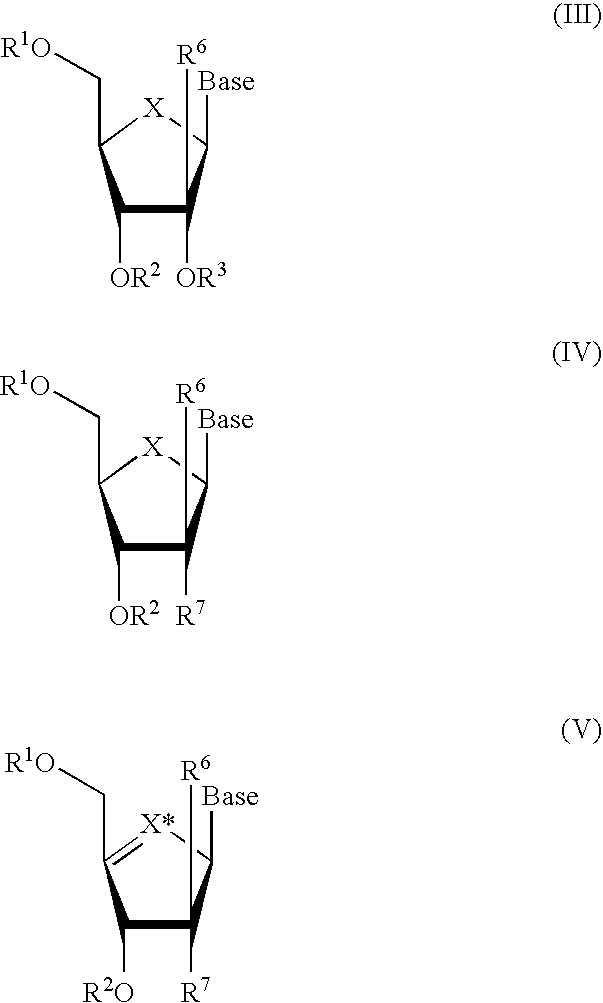Methods and Compositions for Treating Flaviviruses, Pestiviruses and Hepacivirus
a technology of pestiviruses and compositions, applied in the field of compounded methods and compositions for the treatment of flaviviruses, pestiviruses and hepaciviruses, can solve the problems of significant economic losses worldwide and considerable exposure to pestiviruses
- Summary
- Abstract
- Description
- Claims
- Application Information
AI Technical Summary
Problems solved by technology
Method used
Image
Examples
example 1
Phosphorylation Assay of Nucleoside to Active Triphosphate
[0166]To determine the cellular metabolism of the compounds, HepG2 cells are obtained from the American Type Culture Collection (Rockville, Md.), and are grown in 225 cm2 tissue culture flasks in minimal essential medium supplemented with non-essential amino acids, 1% penicillin-streptomycin. The medium is renewed every three days, and the cells are subcultured once a week. After detachment of the adherent monolayer with a 10 minute exposure to 30 mL of trypsin-EDTA and three consecutive washes with medium, confluent HepG2 cells are seeded at a density of 2.5×106 cells per well in a 6-well plate and exposed to 10 μM of [3H] labeled active compound (500 dpm / pmol) for the specified time periods. The cells are maintained at 37° C. under a 5% CO2 atmosphere. At the selected time points, the cells are washed three times with ice-cold phosphate-buffered saline (PBS). Intracellular active compound and its respective metabolites are ...
example 2
Bioavailability Assay in Cynomolgus Monkeys
[0167]Within 1 week prior to the study initiation, the cynomolgus monkey is surgically implanted with a chronic venous catheter and subcutaneous venous access port (VAP) to facilitate blood collection and undergoes a physical examination including hematology and serum chemistry evaluations and the body weight is recorded. Each monkey (six total) receives approximately 250 μCi of 3H activity with each dose of active compound at a dose level of 10 mg / kg at a dose concentration of 5 mg / mL, either via an intravenous bolus (3 monkeys, IV), or via oral gavage (3 monkeys, PO). Each dosing syringe is weighed before dosing to gravimetrically determine the quantity of formulation administered. Urine samples are collected via pan catch at the designated intervals (approximately 18-0 hours pre-dose, 0-4, 4-8 and 8-12 hours post-dosage) and processed. Blood samples are collected as well (pre-dose, 0.25, 0.5, 1, 2, 3, 6, 8, 12 and 24 hours post-dosage) v...
example 3
[0168]Human bone marrow cells are collected from normal healthy volunteers and the mononuclear population are separated by Ficoll-Hypaque gradient centrifugation as described previously by Sommadossi J-P, Carlisle R. “Toxicity of 3′-azido-3′-deoxythymidine and 9-(1,3-dihydroxy-2-propoxymethyl)guanine for normal human hematopoietic progenitor cells in vitro” Antimicrobial Agents and Chemotherapy 1987; 31:452-454; and Sommadossi J-P, Schinazi R F, Chu C K, Xie M-Y. “Comparison of cytotoxicity of the (−)- and (+)-enantiomer of 2′,3′-dideoxy-3′-thiacytidine in normal human bone marrow progenitor cells” Biochemical Pharmacology 1992; 44:1921-1925. The culture assays for CFU-GM and BFU-E are performed using a bilayer soft agar or methylcellulose method. Drugs are diluted in tissue culture medium and filtered. After 14 to 18 days at 37° C. in a humidified atmosphere of 5% CO2 in air, colonies of greater than 50 cells are counted using an inverted microscope. The r...
PUM
| Property | Measurement | Unit |
|---|---|---|
| concentration | aaaaa | aaaaa |
| concentration | aaaaa | aaaaa |
| weight | aaaaa | aaaaa |
Abstract
Description
Claims
Application Information
 Login to View More
Login to View More - R&D
- Intellectual Property
- Life Sciences
- Materials
- Tech Scout
- Unparalleled Data Quality
- Higher Quality Content
- 60% Fewer Hallucinations
Browse by: Latest US Patents, China's latest patents, Technical Efficacy Thesaurus, Application Domain, Technology Topic, Popular Technical Reports.
© 2025 PatSnap. All rights reserved.Legal|Privacy policy|Modern Slavery Act Transparency Statement|Sitemap|About US| Contact US: help@patsnap.com



